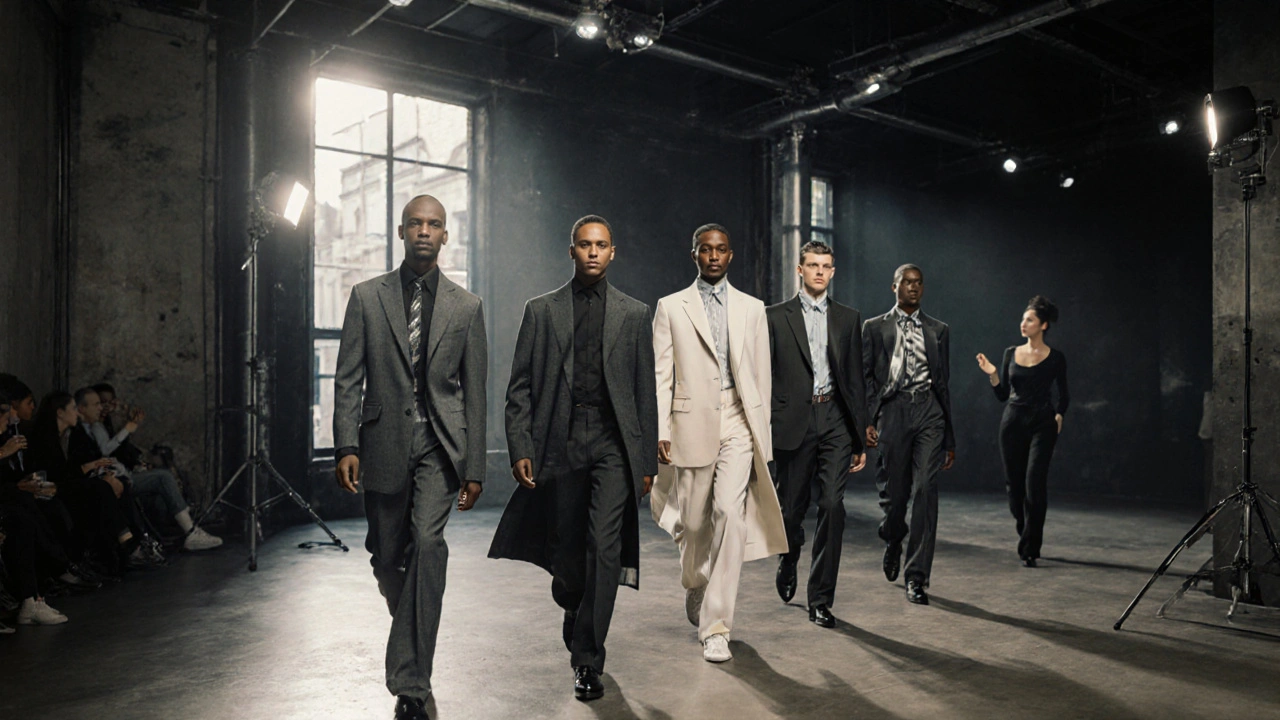If you want to become a fashion model, talent alone won’t cut it. The industry runs on discipline, technique, and professionalism-and those skills don’t just appear overnight. You need training. Not just posing in front of a mirror or copying Instagram influencers. Real, structured education that teaches you how to walk, how to express emotion without words, how to handle a shoot under pressure, and how to protect yourself in a business that’s often unpredictable.
Why Fashion Model Education Matters
Most people think modeling is about looks. It’s not. It’s about consistency. About knowing how to hold a pose for 20 minutes while a team of stylists adjusts your hair and makeup. About reading a photographer’s subtle cues. About walking in heels on a wet runway while cameras flash from every angle.
Top agencies don’t sign raw talent anymore. They sign trained professionals. Agencies like IMG, Elite, and Women Management in New York, London, and Milan now require proof of training before even considering a model for their books. Why? Because clients pay for reliability. A brand doesn’t want to spend $50,000 on a campaign only to have the model freeze during the shoot because they’ve never done a commercial look before.
Education fills the gap between natural beauty and professional performance. It gives you the tools to stand out in a sea of applicants who all look similar. It’s not about becoming someone else. It’s about becoming the best version of yourself-with the skills to back it up.
Core Skills Taught in Fashion Model Training
Good modeling programs don’t just teach you how to walk. They build a full toolkit. Here’s what you’ll actually learn in a serious course:
- Runway walking - Not just stepping forward. Learning how to turn, how to pause, how to shift weight for different fabrics, how to match your pace to music, and how to project confidence even when you’re nervous.
- Posing and expression - How to use your eyes, shoulders, and hands to convey mood. A commercial look isn’t the same as a high-fashion look. A beauty shot needs different energy than a editorial spread.
- Camera awareness - Where to stand, how to angle your body, how to interact with light. Many new models don’t realize the camera sees them differently than a mirror does.
- Portfolio building - What shots you need, what to avoid, how to work with photographers to get the right images. A weak portfolio kills opportunities before they start.
- Industry etiquette - How to behave on set, how to communicate with stylists and agents, how to handle rejection, and how to negotiate contracts without sounding inexperienced.
- Self-care and health - Nutrition, sleep, skin care, and mental resilience. Modeling is physically and emotionally demanding. You need to sustain it.
These aren’t fluffy extras. They’re the foundation of a career that lasts longer than one season.
Top Courses and Workshops to Consider
There are hundreds of modeling schools out there. Most are overpriced and underqualified. Here are the ones actually respected by agencies and industry professionals in 2025:
1. London Model College (UK)
Founded in 2008, this is the oldest and most reputable modeling school in the UK. Their 12-week intensive course covers everything from runway technique to contract basics. Graduates have walked for Burberry, Alexander McQueen, and ASOS. The course costs £1,850 and includes a professional portfolio shoot with a photographer who’s worked with Vogue UK. You don’t need prior experience-just commitment.
2. The Modeling Agency (New York)
Run by former top model and agent Lisa Chen, this program is designed for serious candidates. It’s not a “get famous fast” scheme. It’s a 6-week bootcamp focused on commercial and editorial modeling. Students get direct feedback from agents at IMG and Ford Models. The program includes mock castings, headshot sessions, and a private portfolio review. Price: $2,200. Worth every penny if you’re aiming for New York.
3. Milan Model Academy (Italy)
If you want to break into European high fashion, this is your gateway. Located in the heart of Milan, the academy works closely with Dolce & Gabbana, Prada, and Valentino. Their 8-week program includes runway training with former models from the Milan Fashion Week circuit. Classes are taught in English, but students must be fluent in basic Italian for industry networking. Tuition: €2,100. Includes a trip to Milan Fashion Week as part of the curriculum.
4. Sydney Model Workshop (Australia)
Perfect for those in the Asia-Pacific region. This 10-week course is known for its strong focus on diversity and body positivity. It’s one of the few programs that trains models of all sizes, skin tones, and gender identities. They’ve placed students with David Jones, Country Road, and local Australian Vogue. Cost: AUD $1,600. Includes a free 30-minute consultation with a modeling agent.
5. Online: The Model Edge (Global)
Not everyone can relocate. The Model Edge offers a self-paced, video-based program with monthly live Q&As. It’s led by former top model and coach Rachel Nguyen, who trained models for Calvin Klein and H&M. The course includes 40 video modules, downloadable pose guides, and a private Facebook group with 12,000 active models. Price: $499. It’s not as immersive as in-person training, but it’s the best online option if you’re on a budget or living remotely.

What to Avoid
There are scams everywhere. Here’s how to spot them:
- They ask for money upfront for “registration” or “casting fees.” Legitimate schools charge for training, not for access.
- They promise you’ll be famous in 30 days. Real modeling careers take years. Anyone saying otherwise is selling fantasy.
- They don’t show you who teaches the course. If the instructor’s name isn’t listed, or if they have no industry track record, walk away.
- They don’t offer real portfolio shoots. A good course gives you actual professional images-not selfies with a phone and a ring light.
- They pressure you to sign with their agency. If the school is also an agency, it’s a red flag. They’re making money from you, not helping you succeed.
Trust your gut. If something feels too good to be true, it is.
How to Choose the Right Program for You
Not every course fits every person. Ask yourself:
- Where do you want to work? If you dream of Paris, go for a European program. If you want commercial work in the US, focus on New York or LA.
- What’s your budget? You don’t need to spend $5,000. The London Model College and The Model Edge offer excellent value at lower price points.
- Do you need flexibility? If you’re working or studying, online options like The Model Edge give you control over your schedule.
- What’s your body type? Some programs specialize in petite, curvy, or androgynous models. Make sure the school represents your look.
- What’s the outcome? Ask: “Where did your last graduates go?” If they can’t name even three agencies or campaigns, move on.
The right program won’t just teach you to walk. It will connect you to the people who hire models.
What Happens After the Course?
Finishing a course isn’t the end-it’s the start. Here’s what to do next:
- Update your portfolio with your new images. Remove any old, amateur shots.
- Research agencies that represent models like you. Look at their current roster. Are they signing people with your look?
- Send your portfolio to 5-10 agencies per week. Don’t spam. Personalize each email.
- Attend open calls. Many agencies hold them monthly. Be on time. Be professional. Bring your portfolio and ID.
- Start building your social media presence. But don’t post selfies. Post your professional work. Show your range.
- Keep learning. Take a workshop on acting for models. Learn basic makeup. Understand lighting. The more you know, the more valuable you become.
Success doesn’t come from one course. It comes from consistency, resilience, and continuous improvement.
Frequently Asked Questions
Do I need to be tall to become a fashion model?
No. While traditional runway models are often 5’9” or taller, the industry has changed. Commercial modeling, editorial work, and brand campaigns now hire models of all heights. Many agencies now have dedicated divisions for petite, plus-size, and non-traditional models. Training helps you stand out regardless of your height.
Can I do modeling courses while in school?
Yes. Many students take online courses or weekend workshops while studying. The Model Edge and London Model College both offer flexible scheduling. Just make sure your course doesn’t interfere with your education. A degree can be a backup plan-and many agencies prefer models who are well-rounded.
How long does it take to get signed after training?
There’s no fixed timeline. Some models get signed within weeks. Others take 6-12 months. It depends on your look, your portfolio, and how actively you apply. Training gives you the tools, but you still need to put in the work-sending emails, attending castings, following up.
Are there free modeling courses?
There are YouTube tutorials and free webinars, but they’re not substitutes for professional training. You won’t get feedback, real portfolio photos, or industry connections. Free resources can help you learn basics, but if you’re serious, investing in a real course saves time and avoids costly mistakes.
What’s the difference between a modeling school and an agency?
A modeling school teaches you skills. An agency connects you to jobs. Schools charge for training. Agencies earn a commission (usually 15-20%) from the jobs they book for you. Never pay an agency to represent you-only pay a school to train you. If a company does both, it’s likely a scam.
Next Steps
Start by researching the top three schools that match your goals. Look at their graduate success stories. Reach out to alumni on LinkedIn. Ask them: “Was this worth it?”
Then, pick one course. Don’t wait for the perfect moment. The perfect moment doesn’t exist. The moment you sign up is the moment you begin.
Training isn’t about becoming someone else. It’s about becoming someone who can hold their own in a room full of professionals-and that’s the kind of model the industry is looking for.







November 4, 2025 AT 10:24
Michael Soaries
Been in this game for 5 years and honestly? The real secret isn’t the course it’s the hustle after. I took The Model Edge and it helped but what got me signed was showing up to every open call even when I was broke and tired. Training gives you the tool but you gotta use it every damn day.
November 5, 2025 AT 19:51
Paige Vejnar
OMG YES!! I just finished the London Model College and I’m crying 😭😭😭 Like I went from ‘what even is a catwalk’ to walking for a local designer last week!! My feet still hurt but my confidence? UNSTOPPABLE!! 💃✨
November 6, 2025 AT 23:17
Dr. Atul James Singh
The structural deficit in modeling pedagogy is evident. Most institutions fail to integrate biomechanical alignment protocols with affective modulation training. The London Model College’s curriculum demonstrates a rudimentary grasp of kinesiological principles but lacks longitudinal neuromuscular conditioning metrics. You’re paying for aesthetics not analytics.
November 8, 2025 AT 03:05
Bryan Peele
Why are we even talking about this? Everyone knows modeling is just a beauty pageant with better lighting. If you’re not 6’0” and 110 lbs you’re just wasting your time and $2k. The ‘training’ is just a money grab for people who can’t accept they’re not ‘the look’.
November 8, 2025 AT 18:52
Debbie Nehikhuere
Hey Bryan - I hear you. But let’s be real. That ‘look’ you’re talking about? It’s changing. Fast. I’m 5’5”, curvy, and I walked in New York last season. Training didn’t change my body - it changed how I carried it. Confidence isn’t born. It’s built. And yes, it costs money. But so does therapy. And you’d pay for that.
November 9, 2025 AT 04:26
peter may
One must interrogate the epistemological foundations of this so-called ‘education.’ Is modeling a craft? Or is it merely the commodification of physiognomy under the guise of ‘professionalism’? The industry does not train-it manufactures. And those who pay for it are not students-they are subjects in a spectacle of neoliberal self-optimization.
November 11, 2025 AT 04:18
Vanness Latricia
Y’all I just want to say… I’m 32, a mom of two, and I did The Model Edge while working nights at the diner. I didn’t get signed to IMG but I got a gig with a sustainable swimwear brand and now I’m teaching a free workshop at my community center. This isn’t about being famous. It’s about owning your power. You don’t need to be tall. You just need to believe you belong. And if you’re reading this? You already do. 💪💖
November 12, 2025 AT 05:51
Sean Fimio
wait so like… the milan academy requires basic italian?? like… i’m from canada and i barely passed high school french… is that a dealbreaker?? 😅😅😅 also did anyone else notice the typo in the price? it says €2,100 but the link goes to a .com site that charges in dollars??
November 13, 2025 AT 14:50
Tobia Ciottone
THEY’RE ALL LYING. The agencies don’t care about training. They’re controlled by the same shadow consortium that runs the pharmaceutical industry. They want you weak, insecure, and dependent. The ‘portfolio shoots’? They’re tracking your biometrics. The ‘coaches’? They’re feeding your data to AI facial recognition systems to build beauty profiles for targeted advertising. You’re not becoming a model… you’re becoming a data point. Wake up.